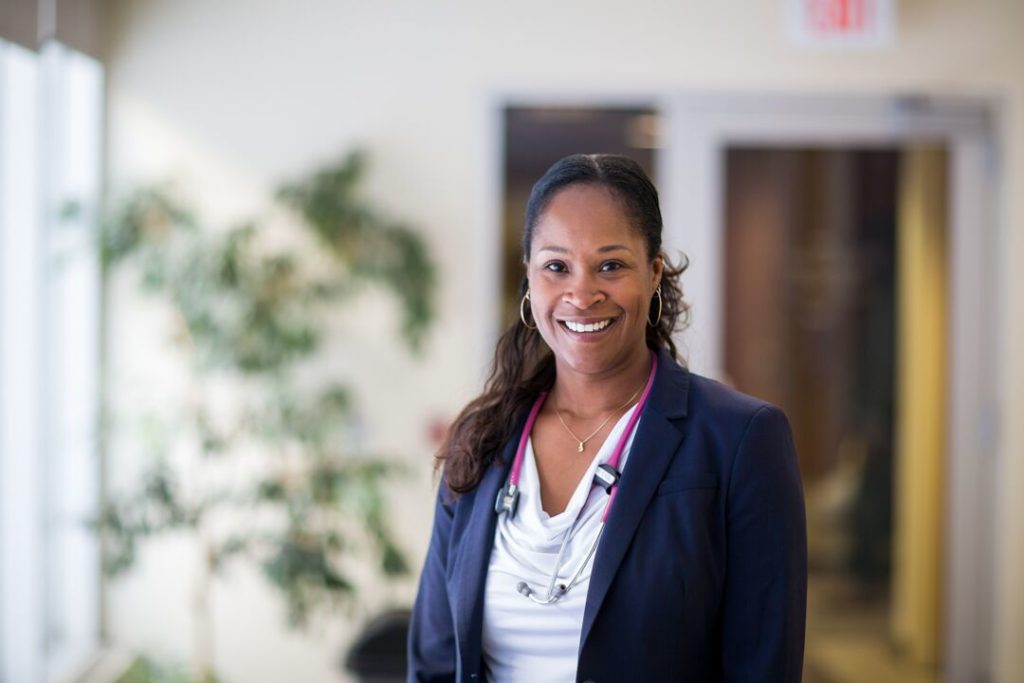
HHS doctor honoured for gender diversity work
A voice for inclusion
When Dr. Natasha Johnson began her career in medicine, she knew she wanted to use her position to help people who are marginalized.
“As a young black girl growing up in the Montreal suburbs in the 70s, it wasn’t the most inclusive experience,” she says. “Overt expressions of welcome meant a lot to me growing up, and so I wanted to do my best to make other people feel included.”
The Pat Mandy Inclusion Award
Her years of work towards this goal were recently acknowledged at Hamilton Health Sciences (HHS) when Dr. Johnson was awarded the Pat Mandy Inclusion Award. This annual award recognizes an HHS staff member or doctor nominated by their colleagues for outstanding work towards inclusion in our hospitals.
“I was surprised that my colleagues would take the time to recognize me and this as important work,” she says. “I was overwhelmed.”
Dr. Johnson was nominated by a large group of colleagues for her work with gender diverse youth at McMaster Children’s Hospital (MCH). She is an adolescent medicine specialist at the hospital and in her work with young patients, realized there was a large gap in care for transgender youth.
“We were referring youth who identify as transgender out to Toronto or to Dr. Carys Massarella at the Quest Community Health Centre in St. Catharines,” Dr. Johnson says. “It became clear that there were a lot of youth in Hamilton that were travelling to get their needs met and I felt we had the means to provide that care closer to home.”
Building capacity to care for gender diverse patients
Dr. Johnson saw how difficult it was for her patients to get to appointments in a different city, especially if they didn’t have the support of their family. She also knew how important safe and professional treatment was to their mental and physical health. She connected with a few colleagues and developed a framework to deliver gender diversity services within the adolescent medicine clinic at MCH. In the year and a half since she began, she has seen overwhelming demand from the community.
“This is still something we have to work on, but we are making progress”
“We estimate that about one per cent of the population is trans,” says Dr. Johnson. “And once they are able to access treatment, they are very dedicated to it. In adolescent medicine, having a high no-show rate is quite common. Among transgender patients, that no-show rate is almost zero. These youth want treatment and they are very keen to come.”
Room for continued improvement
MCH is one of few adolescent medicine clinics in Ontario, and demand for gender diversity services is very high. The service doesn’t have its own funding stream or dedicated space yet, but Dr. Johnson is hoping it will be able to expand in the future. She is also hoping to improve access to services for gender diverse youth by working with primary care providers across the community as part of the Hamilton Trans Health Coalition.
She is also working with other providers and programs within HHS to make the hospital more trans-friendly. Computer-based charting programs aren’t easily adapted to change the name or gender of a patient. While system-wide improvements are being explored, Dr. Johnson and others at HHS are working to share strategies and interim solutions so trans patients can be addressed by their chosen name when they arrive for an appointment. “This is still something we have to work on, but we are making progress” says Dr. Johnson.
There is much more progress to be made at HHS and across the Hamilton community, but Dr. Johnson is optimistic that we are building momentum, and is honoured to be part of the group that is making positive change for people who identify as gender diverse.
